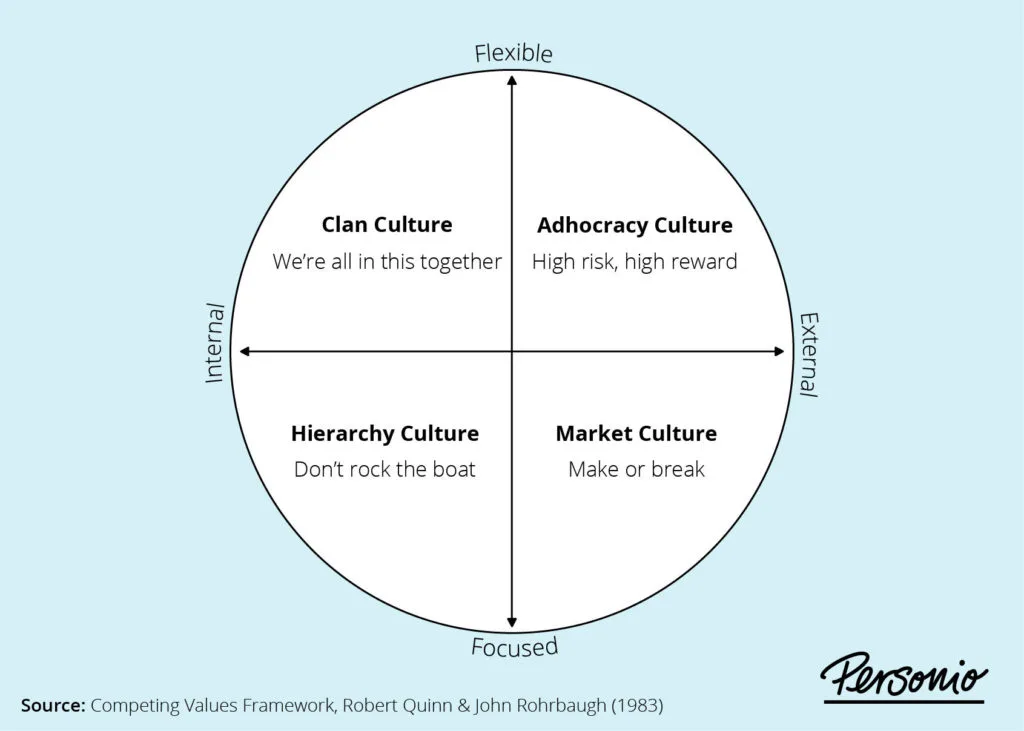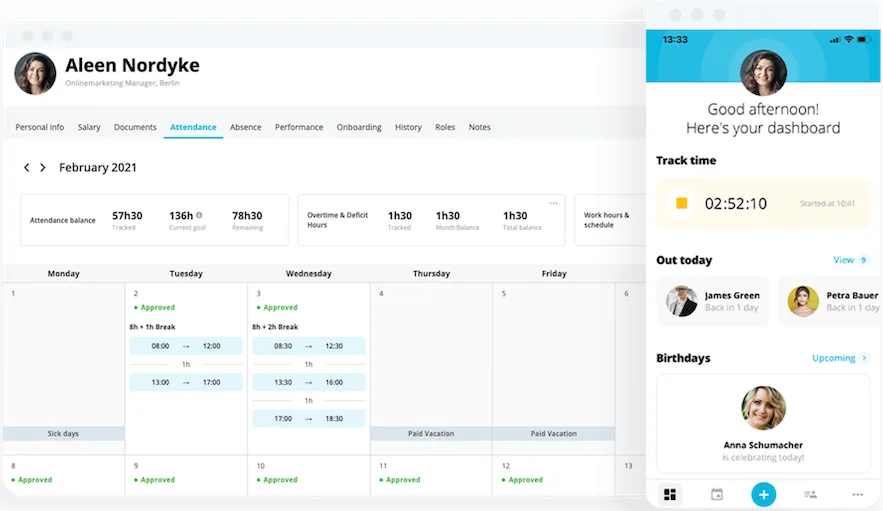Four types of company culture: which one is yours?

Clan culture, adhocracy culture, market culture, hierarchy culture, can you ever have too much culture? In this article, we’ll build on the Competing Values Framework for companies to help understand each of the four types of workplace culture.
It has to be said that workplace culture is certainly not a monolith. It can come in all sorts of shapes, sizes, and forms, and it can evolve over time, too. In short, your corporate culture is flexible, but it needs definition to thrive.
Already prepared for a deep dive into culture? Download our guide today to learn more.Organisational culture: what is it?
Company or workplace culture is the combined beliefs, core values, and customs that your organisation promotes (whether directly or indirectly). Basically, think of it as how your employees feel coming into work in the morning and throughout the day (and how they interact with colleagues). This is a pretty good reflection of the effect your culture is having.
Company culture types: understanding the competing values framework

Understood as one of the strongest ways to put a finger on different company culture types, the Competing Values Framework was crafted in 1983 by researchers Robert Quinn and John Rohrbaugh.
Essentially, it gave rise to four main types of culture:
| Type | In Essence |
|---|---|
| Clan Culture | "We’re all in this together." |
| Adhocracy Culture | "High risk, high reward." |
| Hierarchy Culture | "Stay the course and don’t rock the boat." |
| Market Culture | "Make it or break it." |
These are based on a handful of factors and dimensions, which we’ll explore more as we dive into each type of culture. That said, it helps to think of these two main considerations:
Internal focus (progress) versus external focus (positioning)
Flexibility (individualisation) versus stability (top-down control)
If we consider these dimensions, and where companies place themselves on them as part of a spectrum, we can see these four types of unique cultures reveal themselves.
Organisational culture: the 4 main company culture types
So, let’s dive into it! When it comes to types of company culture, here is the full story behind each and how you might be able to identify it within your own organisation…
What is clan culture?
Clan culture is a ‘one big happy family’ culture. It is where an organisation takes a distinct nurturing tone towards its workforce and focuses on helping them grow within their own sense of responsibility.
Where is clan culture most common?
Clan culture is typical amongst start-up companies who rely on a culture built on empowerment. Clan culture focuses a lot of its efforts on helping employees identify with the company. In that sense, aligning the company’s values with their own employees (and vice versa).
Clan culture is also defined by its focus on mental health at work and employee wellbeing, which is why it can often be seen as the ‘softest’ of the four cultures.
What are the drawbacks of clan culture?
While it can have a positive effect on attrition and professional development, it may lack structure and is more likely to experience growing pains as the organisation scales. That’s because a clan culture is very insulated, making it difficult to scale as time goes on.
What is adhocracy culture?
An adhocracy culture is one based on innovation. Constantly screaming toward the future, it consistently pushes employees to think beyond the typical, innovate, ‘break things,’ and experiment wildly.
What are the benefits of an adhocracy culture?
When done right, these are the kinds of companies that, by way of their employees, craft the future of things. They create and innovate at lightning-fast speeds, and think about the latest trends and how to even go beyond them.
Adhocracy is very much about doing things ‘ad hoc,’ it’s not so much about having a game plan or a map for the future, but drawing that map and designing the future as a company goes along.
What are the drawbacks of an adhocracy culture?
Adhocracy culture can be a beautiful thing, but it also comes with its own downsides. Those being that employees in this kind of culture can be burnt out much faster, pushing attrition rates and staff turnover ever higher.
At the same time, taking wild swings and massive risks can also be incredibly damaging to a company if it doesn’t work out. Adhocracy is about pushing, pushing, pushing, but it may result in pushback from both employees and markets as a whole.
What is hierarchy culture?
Hierarchy culture is as close as you can get to a classic or traditional corporate culture. It is defined primarily by structure. The main feature is a top-down style of management where decisions are made up high and passed down to managers and employees.
What are the advantages of hierarchy culture?
Rule, rules, rules, that’s what hierarchy culture is all about. That’s not a bad thing, though, because those rules craft processes and procedures that keep things running smoothly and keep every employee on the same page.
After all, there is something incredibly attractive about stability. Employees know what to expect, and they are also better prepared from day one to know what they are doing (and to succeed at it, at the same time).
What are the drawbacks of hierarchy culture?
Everyone knows what they are doing, but this is both a gift and a curse. In its worst forms, it can basically root out innovation and push unhappy or unsatisfied employees into the arms of competitors (those who maybe have a greater taste for adhocracy culture).
What is market culture?
Market culture is exactly as it sounds, a culture based on the market for your company’s product or service. Basically, a market culture involves a no-holds-barred focus on numbers, performance, and consistently driving higher.
It’s a culture determined and defined by pressure. The pressure found in a market culture is typically exerted by leaders who expect the best, and even employees who expect the best of themselves.
Is market culture good or bad?
It depends on who you ask. It can push their employees to be their best, at all times. And, the results can be pretty strong, but they can also be dire. It can result in employee burnout, a lack of satisfaction, and it can be pretty damaging to your employer brand.
When is a market culture most common?
Many companies can only adopt a market culture in times of intense financial strife or competition. That’s because, while it can push performance to new heights and basically save a business, it is also unsustainable when it comes to the human factor.
How do you know if you have a negative culture?
Negative culture is a bit of a relative term, and it all depends on how you want to define it. Is your company’s performance suffering, do you have sky-high turnover rates, is employee engagement dropping rapidly?
At the end of the day, it all depends on what matters to your company. So, it’s difficult to say definitively whether you have a positive or negative culture, because one company’s idea of a positive culture may not be the ideal for another.
In general, though, any of the above KPIs should be red flags for just about every company, so it’s more a matter of emphasis on priority. Workplace culture matters, and it matters because leaders can define it, promote it, and change it, too.
Workplace culture is immensely important
While each type of company culture has its positives and negatives, one thing is for certain: Any company needs to have a concrete, meaningful, and intent understanding of the kind of culture it wants to ‘seed’ and promote.
If culture is important to you, we can highly recommend this further reading:



